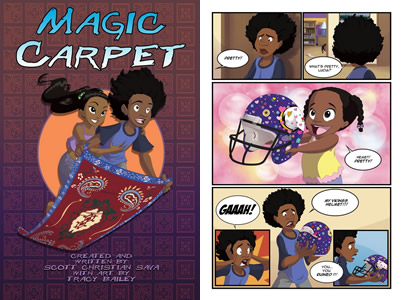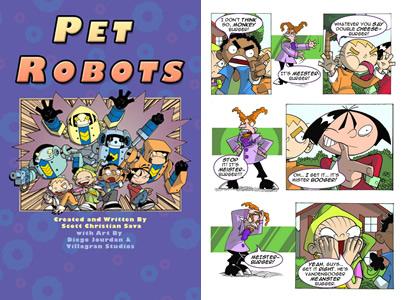In the beginning, there was Spider-Man.
As a boy, Scott Christian Sava loved Spider-Man comics, and though that obsession gave way in time to Conan the Barbarian, the Narnia books, and Tolkien’s Lord of the Rings trilogy, the budding artist never shook his childhood dream of illustrating an issue of Spidey. While studying at the Academy of Art University in San Francisco, Sava pounded the pavement at comic conventions, only to be told that his style—more painterly than the pen-and-ink-work common to comics—didn’t fit the bill.
For the next ten years, Sava channeled his art skills and passion for storytelling into videogame animation and other CGI (computer-generated imagery) projects. “Doing Spider-Man was still my goal,” he says, “but it was a pie-in-the-sky type of goal. I wasn’t focusing all of my energies on it.” Meanwhile, he brought to life several familiar characters of kids’ entertainment: the Power Rangers, Casper the Friendly Ghost, Star Trek. During the mid-nineties, he was animating by day and painting comic book covers by night—for Marvel Comics and other outfits—when Marv Wolfman, a legendary comics creator, suggested he pitch Marvel a comic in the style of CGI animation. “I don’t think anyone had done CGI comics at that point; there were a few attempts at computer-drawn art, but that’s not the same,” Wolfman says. Whereas traditional comics are created with pen and ink on paper, Sava proposed a comic built entirely on the computer, using the same techniques and software he used to create moving images for the screen. The only difference would be that the final product would be static images, or panels—”pictures” taken of what could have become an animated story. Marvel bit, and in 2002 Sava hit his longtime goal, illustrating an issue of Spider-Man and eventually working on some episodes of an animated Spider-Man television series.
 With that boyhood dream realized, Sava set his sights on developing his own comic-book series. He sketched out the narrative arc for what would become The Dreamland Chronicles, an epic fantasy narrative for readers of all ages, featuring Alexander Carter, a twenty-year-old dreamer who rediscovers how to travel to the Dreamland realm he visited in his sleep as a kid. His buddies in that world—Nastajia, Queen of the Elves; a fairy named Kiwi; and Paddington Rumblebottom, a congenial, towering fellow made of stone (he also happens to be a famous dance instructor)—join Alexander in a familiar fantasy trope: a quest pitting the forces of good (Alexander and company) against evil (the venal dragon-king of Dreamland, Nicodemus, and the denizens of the Nightmare Realm).
With that boyhood dream realized, Sava set his sights on developing his own comic-book series. He sketched out the narrative arc for what would become The Dreamland Chronicles, an epic fantasy narrative for readers of all ages, featuring Alexander Carter, a twenty-year-old dreamer who rediscovers how to travel to the Dreamland realm he visited in his sleep as a kid. His buddies in that world—Nastajia, Queen of the Elves; a fairy named Kiwi; and Paddington Rumblebottom, a congenial, towering fellow made of stone (he also happens to be a famous dance instructor)—join Alexander in a familiar fantasy trope: a quest pitting the forces of good (Alexander and company) against evil (the venal dragon-king of Dreamland, Nicodemus, and the denizens of the Nightmare Realm).
Getting Dreamland up and running was not a solitary-artist-hunched-over-drawing-table type of task. Sava describes the project as akin to making an animated feature film, one that has required a sizeable crew over the years—and, to date, about $150,000 in funding out of his own pocket. After coming up with the story’s script and storyboard, he collaborates with character modelers, who sculpt 3-d, computer-generated versions of the characters, and “riggers,” who apply “bones” to the characters so he can move them into position and change their expressions as he sets up each panel of the story.
The final step, in which Sava’s souped-up computer renders each individual panel, can take anywhere from two to twenty hours, depending on the complexity of the panel. “Everything but the storyboard drawing is done on the computer,” he explains. At the end of Book One, Sava includes a credits page—much like motion picture credits—thanking all the people who helped him develop The Dreamland Chronicles initially. (These days, he enlists a core group of six to seven people.)
 Sava first published The Dreamland Chronicles as individual issues of a comic book, with the first collected volume, Book One, appearing in 2006. Reviews were positive—Comic Buyer’s Guide called it “the best all-ages fantasy comic book on the market”—but sales were not what Sava hoped for. He was skeptical when a friend with expertise in Japanese manga, Audry Taylor, suggested that he develop the story as a web comic, in effect serializing the graphic novels online before publishing them in print. Online, teenage girls were much more likely to discover Dreamland, Taylor said. She predicted that those readers would love Sava’s world and its inhabitants—and go on to buy the books. “It’s romantic without being smutty, has a style that hits the sweet spot, and has a lead boy who is both brave and swoon-worthy,” Taylor says. “Talk about a killer combination!”
Sava first published The Dreamland Chronicles as individual issues of a comic book, with the first collected volume, Book One, appearing in 2006. Reviews were positive—Comic Buyer’s Guide called it “the best all-ages fantasy comic book on the market”—but sales were not what Sava hoped for. He was skeptical when a friend with expertise in Japanese manga, Audry Taylor, suggested that he develop the story as a web comic, in effect serializing the graphic novels online before publishing them in print. Online, teenage girls were much more likely to discover Dreamland, Taylor said. She predicted that those readers would love Sava’s world and its inhabitants—and go on to buy the books. “It’s romantic without being smutty, has a style that hits the sweet spot, and has a lead boy who is both brave and swoon-worthy,” Taylor says. “Talk about a killer combination!”
Sure enough, after consistently posting new pages on his website each day for months. Sava had attracted a steady new—and largely young and female—crop of readers. As the father of sons—twins Brendan and Logan, now seven—was surprised at first that Taylor’s hunch proved correct. “I was a thirty-severn-year-old man writing for himself and his three-year-old boys. I wasn’t gearing the story toward girls,” he says. On the other hand, the audience made sense in the context of the Internet. “Comic shops are just not very girl-friendly. Most are dark, smelly, and run by men who still live in basements with their moms,” he jokes. “And most of the female characters are big-breasted, wearing spandex and high heels. But [in web comics], there’s a lot more diversity, and there’s not that deterrent of the dark and dingy man-cave.”
The Dreamland Chronicles now boasts more than ten million readers worldwide, a success that can be chalked up largely to Sava’s sheer persistence and consistency, along with a dash of shrewdness about how to play the web comics game. Every weekday for the past four and a half years, he’s created a new page and posted it at midnight; his output now totals 1,100 pages, and readers typically leave some fortys to sixty comments per day. Considering that Sava feels obligated to keep up a steady flow of communication with his fans—via site comments, email, Twitter, and Facebook—attending to Dreamland demands is no small feat.
 But the process works in his favor, too. The daily posts allow readers to be participants in The Dreamland Chronicles‘ creation. “While it gives them a chance to speculate [about what’s going to happen] with other readers, it lets me see what’s working and what’s not,” he says.
But the process works in his favor, too. The daily posts allow readers to be participants in The Dreamland Chronicles‘ creation. “While it gives them a chance to speculate [about what’s going to happen] with other readers, it lets me see what’s working and what’s not,” he says.
Sava recalls how, 200 pages in, readers were turned off by Nastajia’s coolness toward Alexander. (As they rightly sensed, the two were ultimately destined to be an item.) “I wasn’t going to have that relationship work as fast as it did, but I accelerated it to accommodate the fans,” Sava says. “I try not to let them influence me too much, but the feedback is very cathartic; it keeps me going.”
Sava has the entire story of The Dreamland Chronicles mapped out in his mind, which so far consists of four book-length sections. When he reaches the end of a section, or book, he publishes it as a graphic novel—a typical approach in the comics world, where individual issues of comics in an ongoing narrative are often published together as a book when the narrative is complete. In 2008, he also began publishing shorter graphic novels for young readers, such as Hyperactive, My Grandparents Are Secret Agents, and Gary the Pirate. Those books have been greeted enthusiastically by librarians and reviewers; in a starred review, Booklist wrote that Hyperactive, “with its vibrant, popping art…suggests cartoons like SpongeBob SquarePants and Camp Lazlo, which walk a fine line of creating sophisticated humor that also feels whirlwind and silly, and thus has high appeal for a wide range of ages. With its surprise ending, which suggests more to come, a readership of young boys will ensure that this one flies off the shelf at the speed of light.”
“I love the kids’ books, but it’s a very niche market that needs to grow,” Sava says. “I don’t think book buyers or publishers know what to do with it. But when I went to the ALA conference, the librarians thanked me, saying this is exactly what the kids want and need; they said there’s nothing like this for kids, nothing after picture books and before prose. I think of them as a utensil to help kids learn to read chapter books.”
 Book Four of The Dreamland Chronicles hits stores next month, along with two more graphic novels for young readers: The Luckiest Boy, and Magic Carpet. Sava is pleased by The Dreamland Chronicles’ wide-ranging audience—he’s shipped Dreamland-related drawings, sketches, books, and toys across the globe, everywhere from Iceland to Tokyo to Africa—but he’s also anxious to see his readership continue to grow, for both the Dreamland books and the titles for younger readers.
Book Four of The Dreamland Chronicles hits stores next month, along with two more graphic novels for young readers: The Luckiest Boy, and Magic Carpet. Sava is pleased by The Dreamland Chronicles’ wide-ranging audience—he’s shipped Dreamland-related drawings, sketches, books, and toys across the globe, everywhere from Iceland to Tokyo to Africa—but he’s also anxious to see his readership continue to grow, for both the Dreamland books and the titles for younger readers.
Still, he wonders: as seriously as he takes his relationship with his fans, how will he manage if the following grows much larger—if, say, a Dreamland Chronicles film—which is in the notoriously iffy pre-production stage—ever makes it to theatres?
“I learned coming up through animation to be courteous, to communicate with your clients,” he says. “The fans are my clients, the ones I have to please.” That means not only meeting and greeting at numerous comics conventions (where, naturally, the fans arrive decked out as Dreamland characters), but responding to requests for interviews for school projects, looking at drawings, even playing Scrabble online with readers. “It’s very grassroots, and it’s hard,” he says. “You can’t just ignore emails. You want to respond on a personal level to each and every one of them.”
Sava does have a unique offering on his hands: few, if any, other comics made with CGI animation exist. “I don’t want to say I’m the only one doing it,” he says. “But I’m the only one doing it to this extent.” He laughs. “I guess I’m the only one stupid enough to invest this kind of time and quality in it.” His twin boys and their classmates are duly impressed, however—and they love hanging out in Sava’s office, stocked as it is with G.I. Joe and Star Trek figurines, Rock ‘Em Sock ‘Em Robots, and other items that appeal to the young. For Sava, though, the most gratifying times with Brendan and Logan have nothing to do with action figures: “Sometimes on Saturday mornings I’ll see them in their PJ’s, reading my books—you can’t have a better moment than that.”
Tagged: Children & YA





